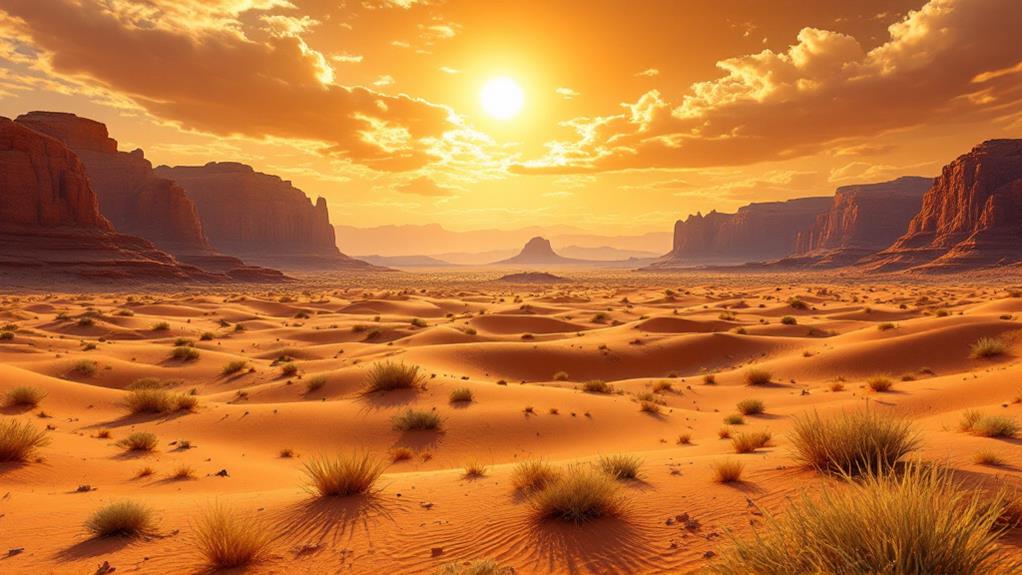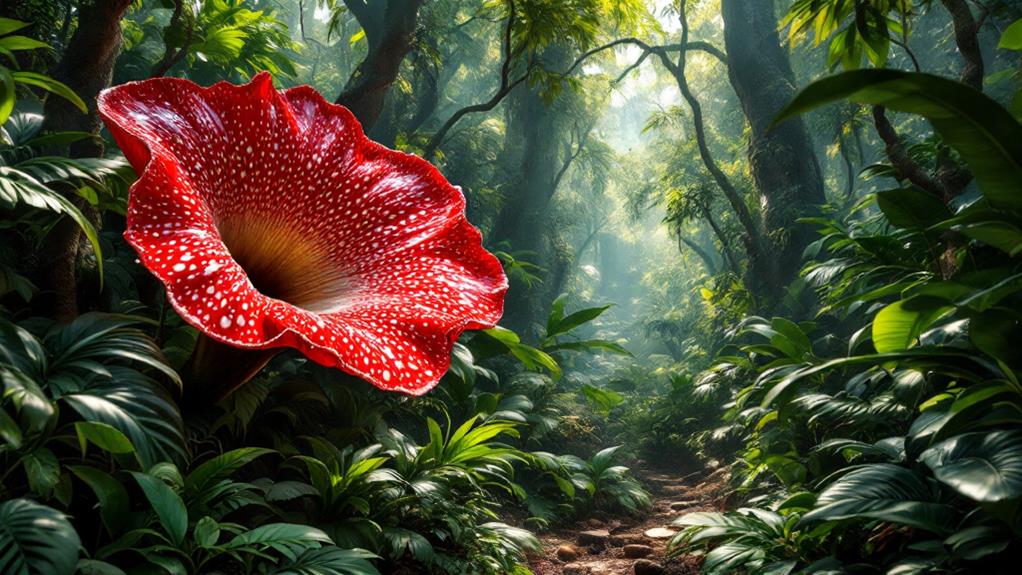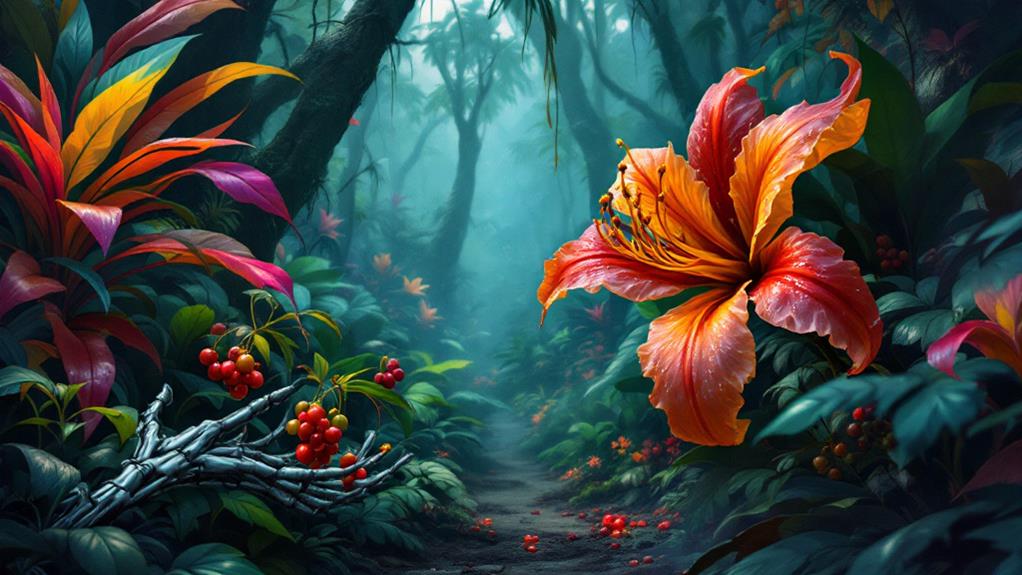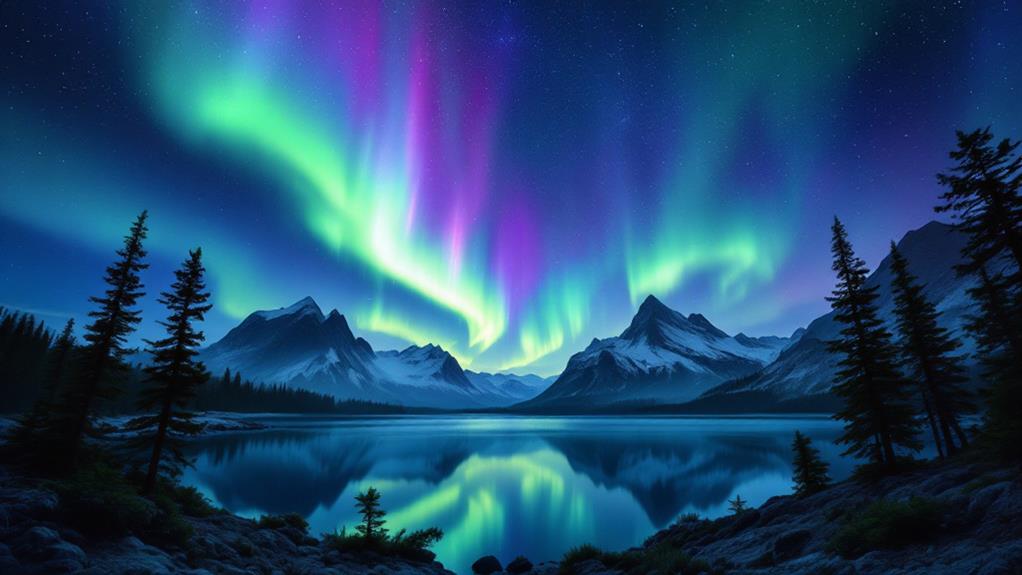The Coldest Places on Earth: Where Temperatures Plummet
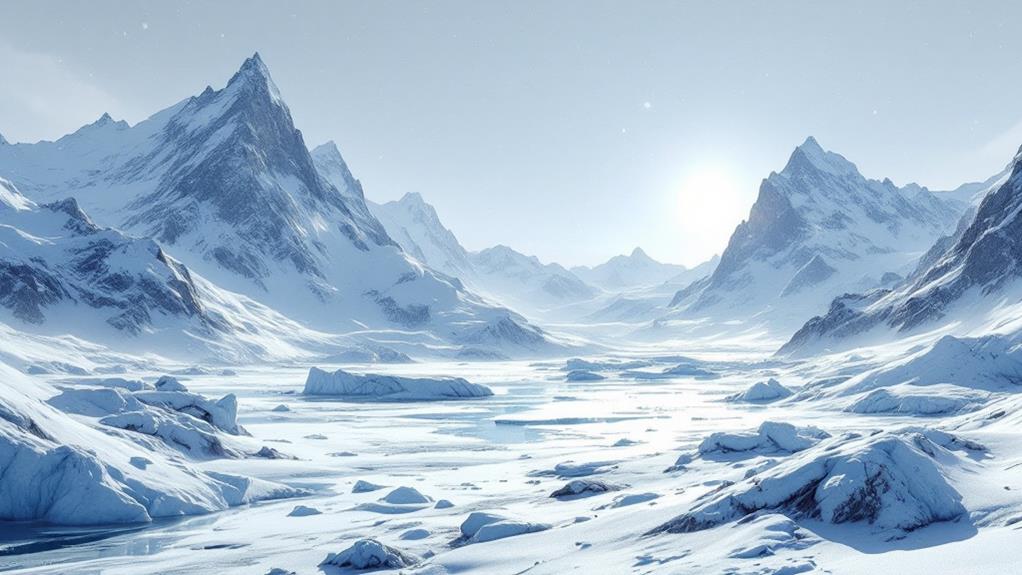
You're stepping into a world of extreme cold by exploring the coldest places on Earth. Antarctica tops the list with mind-numbing temperatures of -89.2°C, while Siberia's icy wilderness is infamous for record lows. Greenland offers Arctic chills with massive glaciers, and Canada's northern territories are no less frigid, featuring places like Snag with notorious cold spells. In Alaska, you'll find not just chilly temperatures but fascinating wildlife adapted to survive. Don't miss the stunning Swiss Alps, Scandinavia's serene cold nights, Mongolia's winter extremes, and Patagonia's harsh climate. Each holds secrets waiting to be uncovered and stories of resilience.
Antarctica: The Icy Continent
When you think about the coldest places on Earth, Antarctica certainly tops the list. This icy continent is not just a vast expanse of freezing temperatures but also a dynamic environment where ice shelf dynamics play an essential role in shaping its landscape. These ice shelves, massive floating platforms of ice, are constantly changing due to the continent's extreme weather conditions. As they crack, melt, and reform, they influence global sea levels and the general stability of the Antarctic ice sheet.
But Antarctica isn't just about ice. It's home to a surprisingly resilient array of Antarctic wildlife. You might be amazed to learn how creatures like penguins, seals, and krill thrive in such a harsh climate. They've adapted to the extreme cold, with penguins huddling together for warmth and seals using their thick blubber for insulation. These animals are integral to the Antarctic ecosystem, relying on the ice shelf dynamics for their survival. For instance, the seasonal melting of ice provides nutrients that support krill populations, which in turn feed larger predators. Understanding these dynamics offers insight into how life endures in one of the most inhospitable places on Earth.
Siberia's Frozen Wilderness
Siberia's frozen wilderness offers an awe-inspiring yet forbidding landscape that challenges even the most seasoned adventurers. As you traverse this vast region, you'll encounter a harsh environment defined by its extreme weather and unique features. The temperatures often plummet to record lows, making it one of the coldest places on Earth. Despite these harsh conditions, Siberia is home to a variety of resilient wildlife.
Imagine standing before a permafrost landscape that stretches endlessly, its surface forever locked in icy hold. Here's what you'll find:
- Frozen Lakes: In winter, Siberia's lakes transform into expansive sheets of ice, creating a surreal and serene vista. Beneath the frozen surface, life remains, awaiting the thaw.
- Siberian Wildlife: You'll spot creatures like the Siberian tiger and reindeer, perfectly adapted to survive in this unforgiving environment.
- Extreme Weather: The weather is notoriously unpredictable, with sudden snowstorms and biting winds that can test your endurance and survival skills.
Whether you're trekking across the tundra or observing the native animals, Siberia's frozen wilderness promises an unforgettable experience. Accept the challenge, and you'll uncover a world unlike any other.
Greenland's Arctic Chill
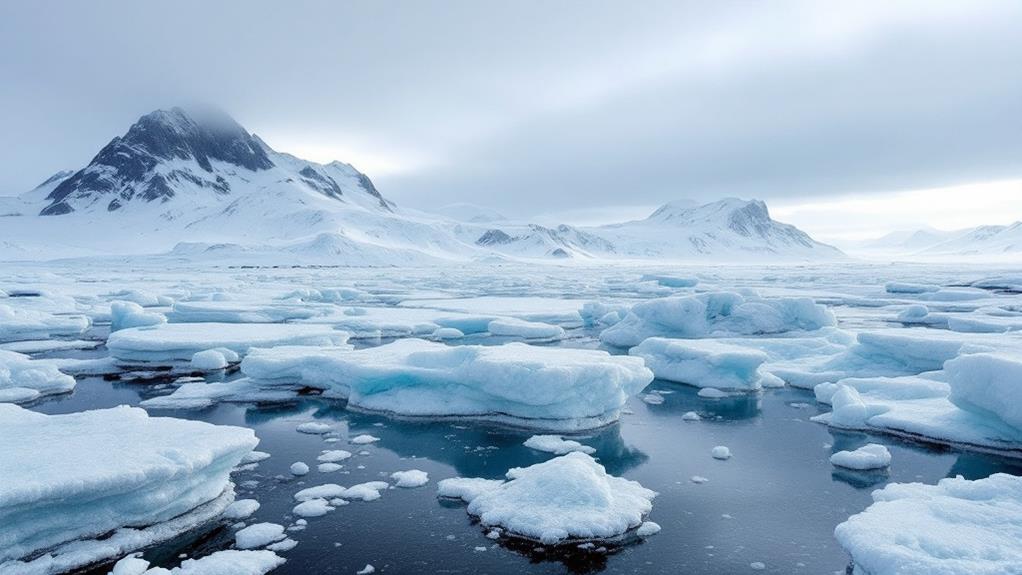
The allure of Greenland's Arctic chill lies in its stark, icy beauty and the quiet strength of its landscapes. As you investigate this immense island, you'll find that Greenland's glaciers offer an awe-inspiring spectacle. These colossal ice formations, some of the largest on the planet, dominate the landscape, creating a frozen world that seems untouched by time. Walking near a glacier, you can hear the ice crack and shift, a sound both haunting and mesmerizing.
Greenland's capital, Nuuk, transforms into a winter wonderland during the colder months. You're greeted by short days and long, frigid nights. Despite the harsh conditions, Nuuk's winter draws you in with its lively culture and the warmth of its people. The city becomes a hub of activity, where locals welcome the cold with festivals and community gatherings. You might feel the bite of the Arctic wind on your cheeks, but the sights and sounds of Nuuk in winter will captivate you.
In Greenland, the Arctic chill isn't just about the cold; it's an experience that connects you to the raw power of nature and the resilience of those who call this frozen land home.
Canada's Frigid Territories
As you leave the icy allure of Greenland behind, Canada's frigid territories beckon with their own brand of cold beauty and stark wilderness. Here, the vast expanses of Yukon, the Northwest Territories, and Nunavut greet you with extreme temperatures that test the limits of winter survival. In these remote areas, the thermometer often plunges below -40 degrees Celsius, turning the landscape into a frozen masterpiece.
- Yukon: In this land, you'll find the notorious town of Snag, which once recorded one of North America's lowest temperatures at -63 degrees Celsius. It's a place where even the air seems to crackle with cold.
- Northwest Territories: Venture into this region, and you'll encounter the town of Fort Good Hope, where the winter chill bites fiercely, creating an environment where survival skills are crucial.
- Nunavut: This territory's isolation intensifies its frigid allure. In places like Resolute, temperatures plummet sharply, demanding respect and preparation from anyone who dares to investigate its icy wonders.
In Canada's frigid territories, the cold is not just felt—it's experienced. These regions challenge you to accept the winter survival mindset, showcasing nature's raw power in its most extreme form.
Alaska's Coldest Regions
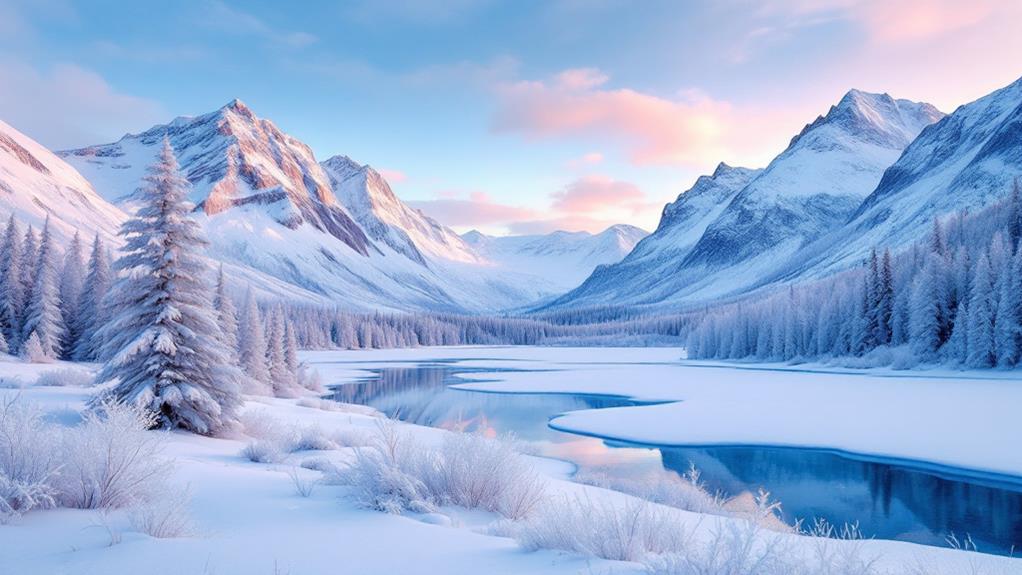
When you venture into Alaska's coldest regions, you're stepping into a world where the chill isn't just a sensation—it's a defining feature of life. Here, temperatures can drop to bone-chilling lows, transforming the landscape into a frozen wilderness. In these harsh conditions, Arctic survival becomes a true test of resilience. You'll find that both humans and Alaska wildlife have adapted in remarkable ways to endure the bitter cold.
As you investigate these frosty expanses, you'll encounter creatures like the Arctic fox and the caribou, each with unique adaptations that guarantee their survival. The Arctic fox, for instance, boasts a dense, insulating fur that changes color with the seasons, while caribou migrate in search of food, maneuvering the icy terrain with their large, snowshoe-like hooves. These animals are experts in conserving energy, a vital skill when every calorie counts.
For humans, mastering Arctic survival means understanding and respecting the land. You need the right gear, a deep knowledge of the environment, and an appreciation for the delicate balance that allows life to persist in one of Earth's most unforgiving climates. Here in Alaska, the cold isn't just a backdrop—it's a way of life.
The Swiss Alps Freeze
In the heart of Europe, the majestic Swiss Alps transform into a winter wonderland as temperatures plummet and the landscape becomes blanketed in a pristine layer of snow. As you navigate this frosty paradise, you'll uncover that the cold breath of winter turns the Alps into a haven for Swiss skiing enthusiasts. The crisp air and breathtaking vistas offer more than just a chill; they invite a thrill.
When you visit, imagine yourself amidst:
- Powdered Slopes: Perfect for thrilling descents, the Swiss Alps' slopes are a skier's dream, offering varied terrains for both novices and experts.
- Alpine Glaciers: These ancient ice formations shimmer under the winter sun, creating a surreal backdrop that captivates any onlooker.
- Snow-Draped Villages: Quaint, picturesque villages nestle in the valleys, their rooftops burdened lightly with snow, exuding a cozy charm.
The Alps are not just about the skiing; their Alpine glaciers tell stories of eras past, and they present a stark beauty that stands resilient against the harsh winter. You can't help but marvel at the sheer magnitude of nature's artistry in this frozen domain. As you enjoy the Swiss skiing experience, the tranquility of this icy expanse offers a unique, invigorating escape.
Chilly Nights in Scandinavia
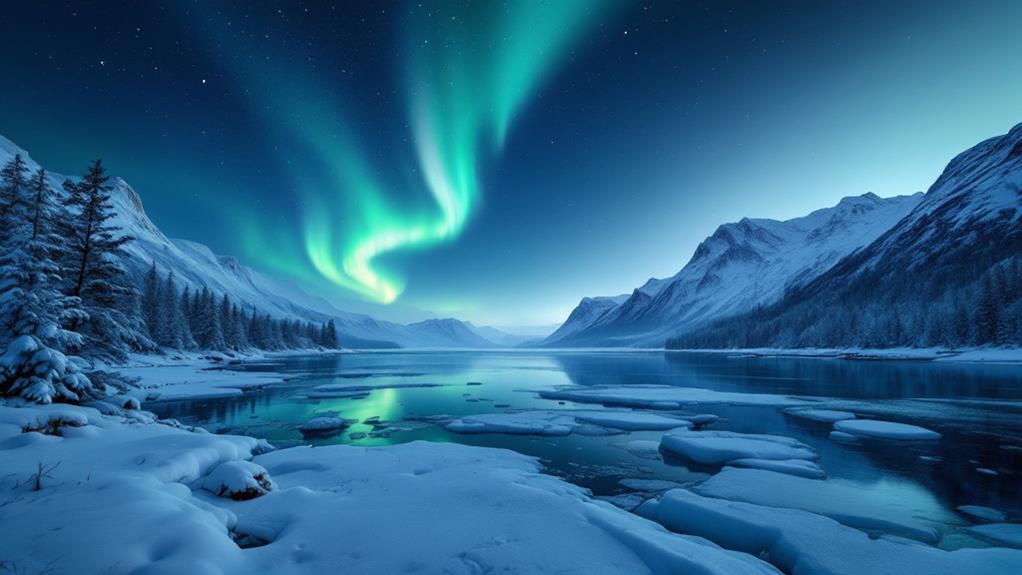
Picture yourself under the vast, starry sky of Scandinavia, where chilly nights envelop the landscape in an ethereal glow. The air is crisp, and the ground crunches beneath your feet. As your breath forms clouds in the icy air, you're reminded of the Scandinavian folklore that speaks of mythical creatures and ancient spirits wandering these frozen lands.
On these cold nights, you may be fortunate enough to witness the dazzling Northern lights. The aurora borealis paints the sky with lively hues of green, pink, and purple, casting a mystical light over the snow-covered landscape. It's a sight so mesmerizing that it's easy to see why it's been woven into countless tales and legends.
As you wander, the chill of the Scandinavian night becomes a comforting companion, adding to the magic of the experience. You're walking through a world where nature's beauty and mystery intertwine seamlessly. Each step reveals more of the stunning scenery, from frozen lakes to snow-laden forests. You can't help but feel connected to the land and its stories, where the past and present merge under the shimmering night sky.
Mongolia's Winter Extremes
Mongolia's winter is not for the faint-hearted, as temperatures can plunge to a bone-chilling -40 degrees Fahrenheit. In such extreme weather, even the most basic activities require strategic planning. You'll witness how Mongolian winters test the resilience of its people and shape their unique nomadic lifestyle. Here, cultural adaptations are crucial to survival.
Imagine this:
- Frozen Landscapes: The vast steppes are covered in a thick blanket of snow, transforming into a serene, white wilderness.
- Temperature Fluctuations: One day might be a harsh -40 degrees, while the next could see a slight thaw, demanding constant adjustments.
- Icy Legends: Stories of survival and endurance echo through generations, inspiring the community to adapt.
Mongolians have honed survival strategies over centuries, relying on their resourcefulness. The ger, a portable round tent, is ingeniously designed to withstand the cold, providing warmth and mobility. Herding livestock is a crucial part of the nomadic lifestyle, and traditional clothing made from animal hides offers significant protection against the biting cold.
In Mongolia, you'll encounter a world where extreme weather isn't just a challenge—it's a way of life, sculpting both the land and its people.
The Harsh Climate of Patagonia
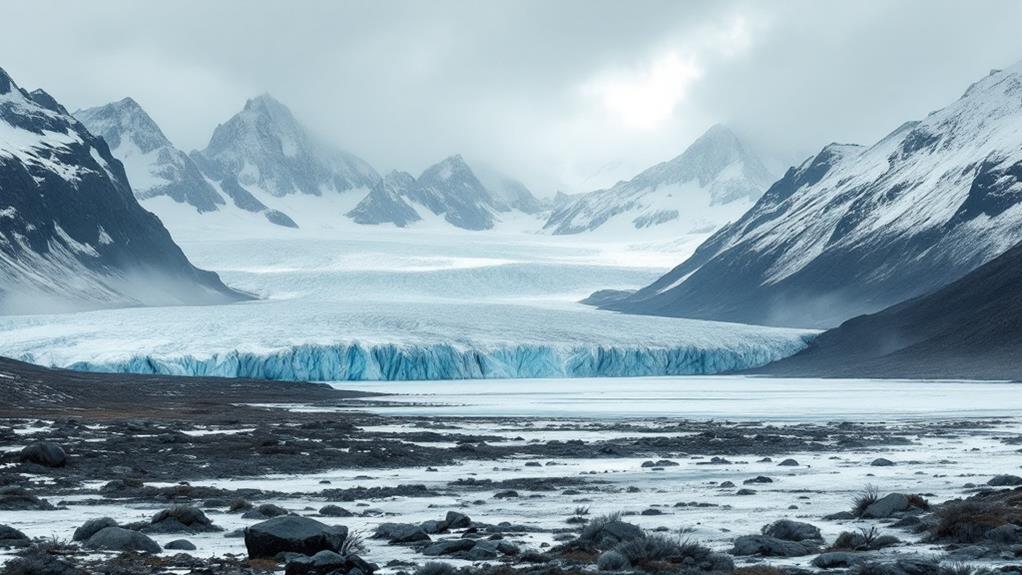
While Mongolia's winters are a demonstration of human resilience, Patagonia offers its own unique climatic challenges. As you investigate this region, you'll encounter Patagonia's glaciers, which form a breathtaking icy expanse that captivates adventurers and scientists alike. These massive ice formations are not only visually stunning but also vital to understanding climate change impacts.
Patagonia's weather can be unpredictable, with fierce winds and sudden temperature drops. It is important to prepare for all conditions if you're venturing into this wild terrain. Despite the harsh climate, Patagonia's landscapes are nothing short of spectacular. From sprawling steppe to rugged mountains, the region offers a diverse and dramatic backdrop that attracts nature enthusiasts and photographers worldwide.
The harsh environment supports a unique array of Patagonia's wildlife, including guanacos, condors, and the elusive puma. You might find yourself marveling at how these species have adapted to such challenging conditions.
Investigating Patagonia also means engaging with Patagonia's indigenous cultures, which have thrived here for centuries. Their knowledge and traditions provide valuable insights into living harmoniously with nature. Patagonia's adventure tourism offers opportunities for trekking, climbing, and kayaking, inviting you to engage deeply in this remarkable and resilient land.
